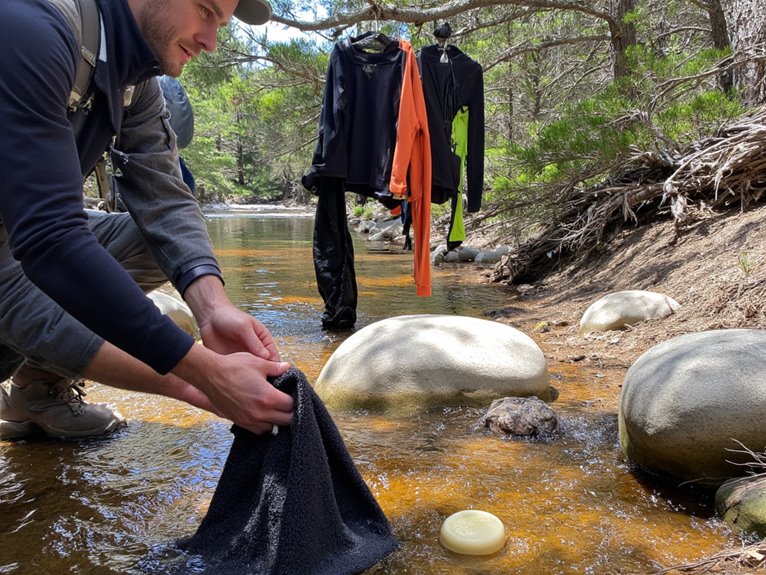Caring for Merino Wool and Synthetic Base Layers on Extended Trips
You’ll need different care strategies for merino wool versus synthetic base layers during extended trips. Merino wool’s natural antimicrobial properties allow multiple wears between washes, while synthetics require more frequent cleaning due to odor buildup. Use cold water and wool-specific detergents for merino layers, avoiding fabric softeners that damage fibers. Air dry both materials away from direct sunlight, and turn garments inside out during washing to prevent pilling. Mastering these techniques guarantees peak performance throughout your adventure.
We are supported by our audience. When you purchase through links on our site, we may earn an affiliate commission, at no extra cost for you. Learn more. Last update on 16th December 2025 / Images from Amazon Product Advertising API.
Notable Insights
- Merino wool’s antimicrobial properties allow multiple wears without washing, making it ideal for extended trips with limited laundry access.
- Synthetic base layers require more frequent washing due to odor buildup, but dry quickly for convenient cleaning during multi-day adventures.
- Pack wool-specific or pH-neutral detergents and avoid bleach, enzymes, or fabric softeners that can damage natural wool fibers.
- Air dry garments flat or in shade, never in direct sunlight, and ensure complete dryness before packing to prevent mildew.
- Turn base layers inside out when washing and storing to reduce pilling and surface wear from repeated use and friction.
Understanding Merino Wool Properties and Performance Benefits
Understanding Merino wool’s unique properties starts with recognizing its natural origin from Merino sheep fleece, which creates a renewable and biodegradable fiber that won’t contribute to microplastic pollution.
The fine fiber structure measures 18-20 microns, delivering softness without traditional wool’s itchiness.
Temperature regulation occurs through the wool’s rippled structure, which forms air chambers that trap warm air in cold conditions while facilitating cooling when temperatures rise. You’ll experience effective insulation year-round through this natural mechanism.
Moisture management capabilities allow Merino fibers to absorb up to 35% of their weight in moisture without feeling wet. The hydrophilic fibers transport sweat from your skin to the fiber core, then release it to the environment.
This prevents clamminess during intense activity while maintaining dryness through superior breathability and quick-drying properties. The antimicrobial properties of Merino wool naturally suppress odor-causing bacteria, allowing you to wear base layers for multiple days without washing during extended outdoor adventures.
Merino wool’s long-lasting durability makes it an excellent investment for outdoor enthusiasts who need reliable performance gear that withstands repeated use in challenging conditions.
Washing and Refreshing Techniques for Merino Base Layers
Proper washing techniques preserve Merino wool‘s performance characteristics while extending garment lifespan through careful handling and appropriate cleaning methods.
You’ll need wool-specific or pH-neutral detergents to protect fibers from damage. Avoid bleach, enzymes, and fabric softeners that degrade wool’s natural properties.
Machine wash on gentle cycles using cold or warm water—never hot. Turn garments inside out to reduce pilling and surface wear. For mixed-material base layers containing Merino and synthetic fibers, follow wool care requirements since they’re more restrictive.
- Pre-treat stains immediately using wool-safe removers without bleach or harsh chemicals
- Select gentle wash cycles with cold/warm water temperatures to prevent shrinkage
- Use mild detergents specifically formulated for wool or pH-neutral formulations
- Close all fasteners before washing to prevent snagging and fabric damage
Effective stain treatment requires prompt action and appropriate solutions for different stain types.
Proper Drying and Storage Methods
Three critical factors determine successful base layer maintenance after washing: drying method, storage conditions, and heat exposure management. Effective drying techniques preserve fiber integrity while preventing damage.
Air dry merino wool flat on clean towels or hang in shade, avoiding direct sunlight and radiators that cause shrinkage. Never wring wet wool—gently squeeze excess moisture instead. Polyester dries faster but benefits from similar gentle handling.
Smart storage solutions extend garment lifespan considerably. Confirm complete dryness before storage to prevent mildew development.
Fold base layers rather than hanging to avoid shoulder deformation. Use breathable containers with natural airflow, keeping wool away from pests through natural repellents.
Rotate stored items periodically during extended trips to prevent permanent creasing and maintain performance properties.
Managing Pilling, Repairs, and Garment Maintenance
When short wool fibers break and tangle during wear and washing, they form small fiber balls called pills that affect your base layer’s appearance and performance. Effective pilling prevention starts with proper washing techniques and fabric care.
Proper washing techniques and fabric care form the foundation of effective pilling prevention for wool garments.
Here are four essential strategies for managing pilling and maintaining your garments:
- Turn garments inside out before washing to reduce surface friction and protect outer fibers from mechanical stress.
- Use fabric combs or sweater shavers to gently remove existing pills without damaging the underlying fabric structure.
- Limit washing frequency since merino wool’s natural odor resistance allows multiple wears between cleanings.
- Access professional repair services at outdoor gear stores for darning small holes and tears before they expand.
Store garments away from direct sunlight and separate from items with zippers to prevent snagging and fiber degradation. Following proper care instructions is especially critical for merino wool base layers, which have specific washing and drying requirements that differ from synthetic materials.
Synthetic Base Layer Care and Multi-Day Trip Strategies
Unlike merino wool’s natural antimicrobial properties, synthetic base layers require different care strategies to maximize their performance advantages during extended backcountry trips.
Synthetic moisture wicking capabilities excel during high-intensity activities, moving sweat away from your skin more efficiently than natural fibers. You’ll need to wash synthetics more frequently to control odor buildup, as polyester and nylon lack wool’s inherent antimicrobial protection.
For multi day layering systems, choose lightweight synthetic base layers that dry within minutes in favorable conditions. Moisture-wicking fabric is essential for keeping feet dry and reducing the risk of blisters during extended outdoor activities.
Wearing underwear beneath your synthetic layer reduces direct skin contact and minimizes microbial growth. Machine washing maintains peak wicking performance, though some odor retention may persist despite multiple washes.
Antimicrobial treatments like Polygiene® help delay odor buildup but don’t eliminate it entirely. Choose moisture-wicking underwear made from bamboo-spandex blends or synthetic fabrics with odor protection technology to complement your base layer system.
Frequently Asked Questions
How Many Merino Wool Base Layers Should I Pack for a Two-Week Trip?
Pack 2-4 merino wool base layers for your two-week trip. Your packing strategies should balance weight with comfort, while merino’s clothing versatility and odor resistance lets you wear each shirt multiple days between washes.
Can I Mix Merino Wool and Synthetic Base Layers in the Same Wash Load?
You shouldn’t mix them due to different care requirements. For proper fabric care, wash separately using appropriate detergents. Follow these laundry tips: secure zippers, use gentle cycles, and avoid fabric softeners for both materials.
What’s the Best Way to Dry Base Layers When Camping in Humid Conditions?
Maximize airflow by hanging base layers in open, breezy areas away from tents. Spread garments flat to increase surface exposure. These drying techniques combat humidity considerations by promoting faster evaporation than enclosed spaces.
How Do I Prevent Merino Wool Base Layers From Developing Permanent Body Odor?
You’ll prevent permanent odor through proper washing techniques using cold water and wool detergent. For effective odor prevention, wash inside-out regularly, air dry completely, and store in breathable containers with activated charcoal pouches.
Should I Size up or Down When Buying Merino Base Layers for Layering?
You don’t need to size up or down for layering since merino base layers are designed true-to-size. Your sizing considerations should focus on preferred fit, while layering techniques work effectively with standard sizes.
On a final note
You’ll extend your base layers’ lifespan considerably by following proper care protocols. Merino wool requires gentle washing with pH-neutral detergents and air drying at temperatures below 85°F. Synthetic fabrics tolerate more aggressive cleaning but need immediate odor treatment. Regular maintenance prevents pilling and fabric degradation. Store both materials in breathable containers with cedar blocks for moisture control. These techniques guarantee peak performance throughout multi-day adventures.

